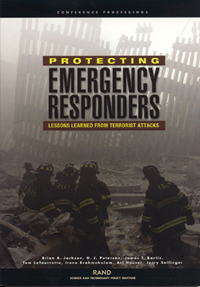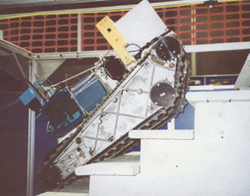

Spring Issue -- 2002
Page 1
Robots Used in Search and Rescue
RAND Completes
Emergency Responder Needs Study
Page 2
Shinjuku
Fire - Fire Test Summary
Page 3
Fire
Fighters Receive Wireless Alarm Information
Page 4
Goats Can Reduce Wildland Fire Danger in WUI Areas
PRINT
FRIENDLY VERSION (PDF format) ![]()

Robots are being used everywhere as: guards, disposal specialists, lawn mowers, or cleaners who vacuum rooms. They also have been in USAR (Urban Search and Rescue) and were called upon to assist in the search and rescue mission at the World Trade Center on September 12, 2001. After the Fire Department of New York (FDNY) determined it was safe enough to enter the site, roboteers from the Center for Robotic-Assisted Search and Rescue (CRASAR), the University of Southern Florida (USF), iRobot, and Foster-Miller (FM) assisted in the search and rescue mission. USF and FM located a victim shortly after their arrival at the site. Robots also were useful in locating dead end routes, thereby saving rescuers time. They also discovered several intact offices within the debris. When a tether was added, the robots could search about 30 feet ahead of the firefighters.
A
firefighter went down into the intact rooms after a hole was made and
located several more bodies. Robots
also were used when the crawl space was too small for a dog. The experience was one of joint cooperation between the fire
department and the roboteers.
Adam Jacoff is in charge of NIST’s Standardized Test Course for Urban Search and Rescue Robots, tethered or radio connected. He is looking at another part of the robot phenomenon. How NIST can develop a facility dedicated toward accelerating the advancement of the capability of autonomous mobile robots. Adam and his colleagues have developed an evaluation course, with three levels of difficulty. The course is a test bed for new software and robot designs, in addition to ensuring standardization.
The
course can be assembled and used each year at the American Association
for Artificial Intelligence (AAAI) annual competition anywhere in North
America.
AAAI-2002 Mobile Robot Competition and Exhibition will be held in
Edmonton, Alberta, Canada, 28 July – 1 August 2002.
For more information go to the web site:
www.cs.uml.edu/aaairobot/.
Cont.
on page 2

In
the aftermath of the September 11, 2001 attacks, the National Institute
for Occupational Safety and Health (NIOSH) asked RAND to assess the
equipment, training and information required to protect emergency
responders as they meet the increased challenges of protecting their
communities in the event of acts of terrorism.
The RAND report, Protecting Emergency Responders: Lessons Learned from Terrorist Attacks,
summarizes the results of a conference
held in New York City on Dec. 9-11, 2001, and organized by the RAND
Science and Technology Policy Institute.
Participants were emergency workers from around the country who responded to the bombing of the Alfred E. Murrah Building in Oklahoma City, the September 11 attacks on the World Trade Center and the Pentagon, and the anthrax incidents that occurred during autumn 2001.
The report may be viewed and
downloaded, free of charge, from the RAND web site http://www.rand.org/publications/
CF/CF176/
.
The
report features first-person accounts from attendees. For example,
according to one of the participating firefighters, "Firefighting
equipment is designed well for firefighting operations that typically
last 30 minutes, 40 minutes, or an hour.
Cont. on page 3